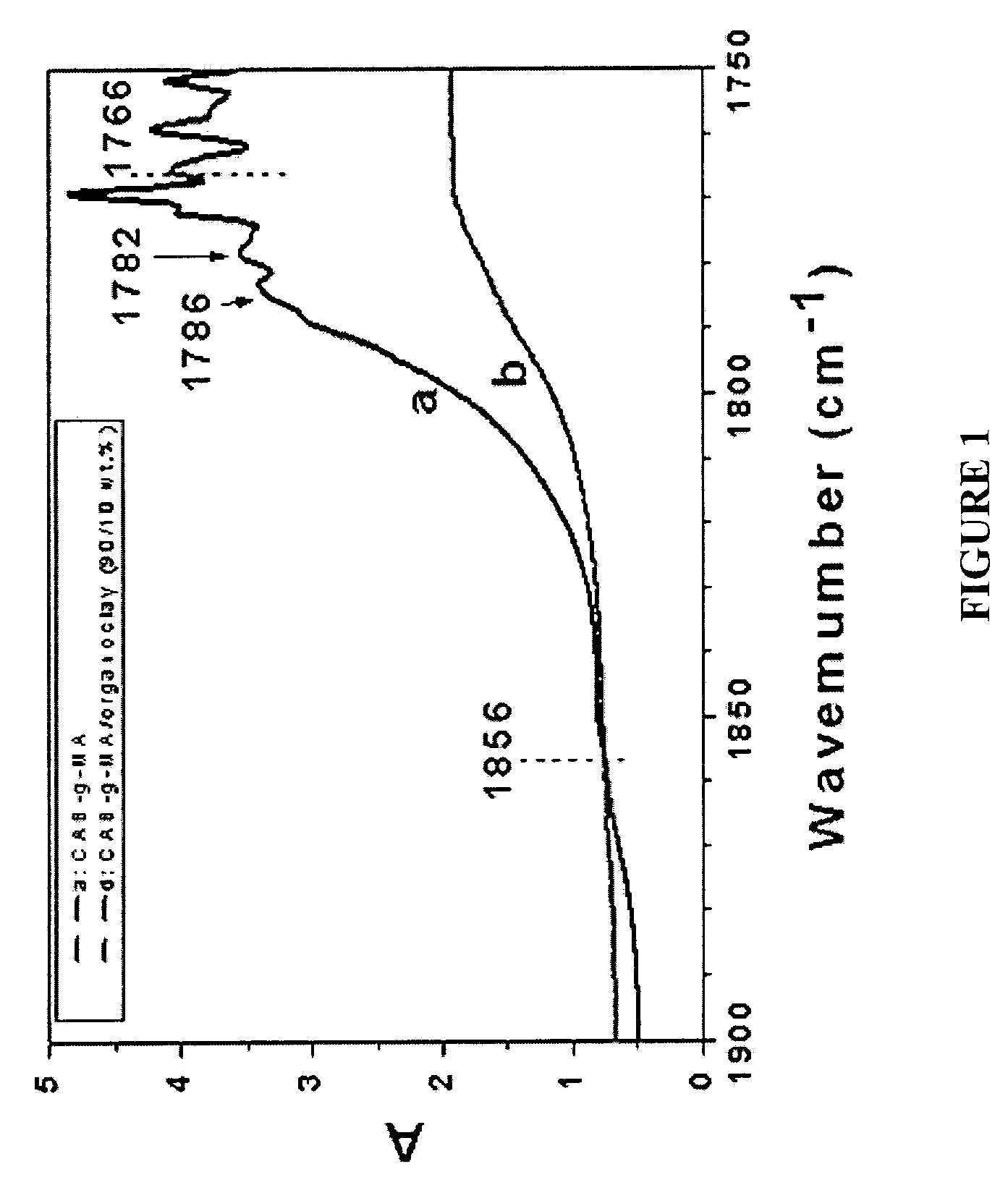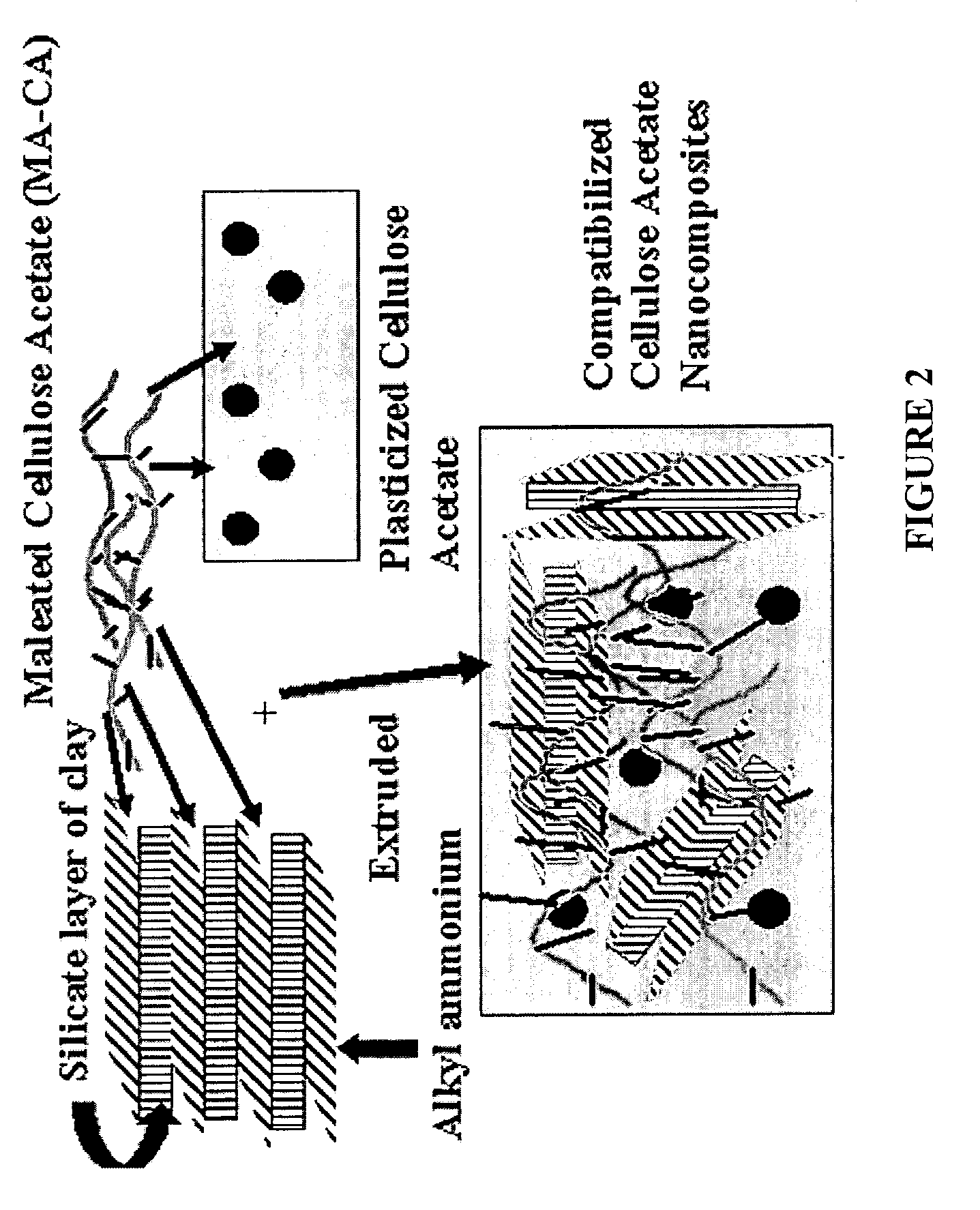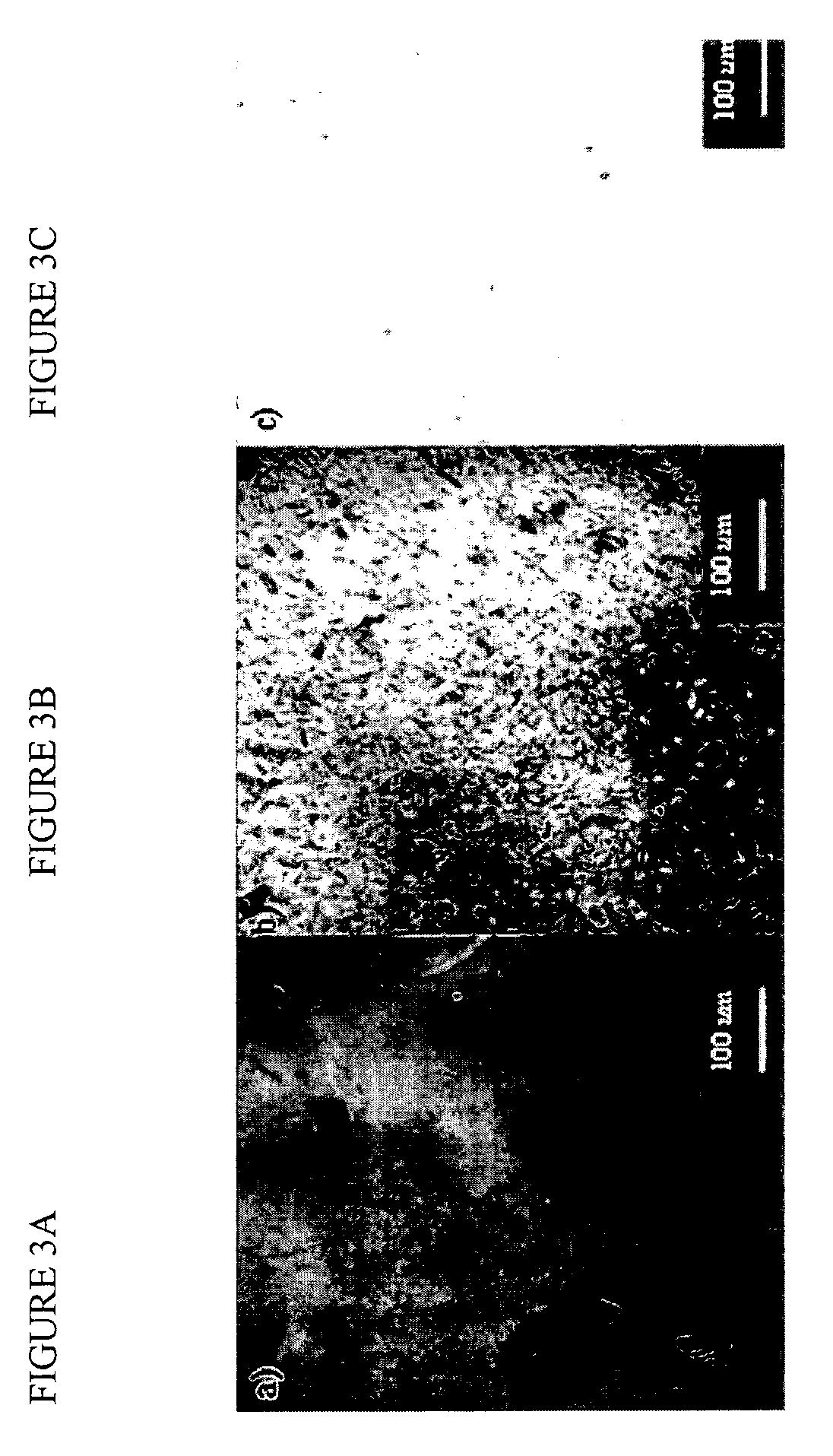Compositions of cellulose esters and layered silicates and process for the preparation thereof
a technology which is applied in the field of compositions of cellulose esters and layered silicates and process for the preparation thereof, can solve the problems of environmental and perhaps a health threat, bio-based economy presents significant challenges to industry, academia and agriculture/forestry, and the components of the mixture do not posses satisfactory compatibility, etc., to achieve the effect of effective binding, improved thermal stability of ca nanocomposite and compatibilizer, and improved tensile strength
- Summary
- Abstract
- Description
- Claims
- Application Information
AI Technical Summary
Benefits of technology
Problems solved by technology
Method used
Image
Examples
example 1
Sequential Mixing Methods and Pre-Plasticization
[0079]The CA and clay were dried under vacuum at 80° C. for at least 24 hours before use. The CA powder and TEC plasticizer (CA / TEC=80 / 20 by wt. %) were mixed mechanically with a high speed mixer for about 5 min and CA pre-plasticized mixture was stored in zip-lock bags for 20, 40, and 75 minutes. These pre-plasticized mixtures were then mixed with 5 wt % of organoclays followed by mixing with the high-speed mixer. These mixtures (CA+TEC+Organoclay) were then melt compounded at 200-220° C. for 6 minute at 100 rpm with the DSM micro-compounding equipment.
[0080]FIGS. 3A, 3B and 3C show the micrographs of different sequential mixing methods for CA powder, clay, and non-solvent type plasticizer TEC for homogeneous clay dispersion hybrid nanocomposites. FIG. 3A shows an optical microscope image of the plasticized CA / TEC pellets mixed with clay and then melt compounded. FIG. 3B shows the results of addition of clay powder while melting the C...
example 2
Pre-Plasticizing Methods
[0083]Microstructure of Nanocomposites: FIGS. 4A, 4B and 4C show the XRD patterns of pure CLOISITE 30B clay and CA / TEC / CLOISITE 30B nanocomposites after different pre-plasticizing times. The XRD peak shifted from 5.00 for pure CLOISITE 30B to 2.8° for 20 minute and 40 minute pre-plasticized CA / TEC CLOISITE 30B nanocomposites (FIGS. 4A and 4B). This indicates significant intercalation and slight exfoliation. For CA / TEC / CLOISITE 30B nanocomposite after 75-minute pre-plasticizing times (FIG. 4C), no clear peak was observed at 2.8°, suggesting complete exfoliation of organoclays in the CA / TEC matrix. In the XRD curves, approximately 75 minute of penetration times is required for the CA / TEC / clay nanocomposites to be almost completely exfoliated.
[0084]Mechanical Properties: Table 2 shows typical flexural properties of the CA / TEC / CLOISITE 30B hybrids with different pre-plasticizing times. The flexural strength and modulus of the CA / TEC / organoclay hybrids increased w...
example 3
Organoclay Type
[0086]Microstructure of Hybrid: Four different types of organoclays were investigated and the properties of the resulting nanocomposites were measured. The organoclays CLOISITE 30B, I.34TCN and I.34TCA have free OH groups; whereas the clay Nanomer I.44PA has no free OH group in its structure. FIG. 5A represents the XRD patterns of the four different organoclays while FIG. 5B shows the XRD patterns CA / TEC / organoclay hybrids with a clay content of 5 wt. %. It can be seen that the dispersion states of clays in the CA / TEC matrix system depends on the type of the clay used. FIGS. 5A-5D) shows the Nanomer I.44PA clay exhibits peaks in the range of around 3.23° (d001 spacing=2.73 nm) due to the organic modified clay. FIG. 5B shows the XRD patterns of the CA / TEC / Nanomer I.44PA hybrid showing an intensive peak at 2θ=2.6°. The appearance of the new peak at 2.6° (d001 spacing=3.8 nm) e.g. a shift from the original peak of the clay at 2θ=ca. 3.23° indicates the intercalation of C...
PUM
| Property | Measurement | Unit |
|---|---|---|
| weight ratio | aaaaa | aaaaa |
| weight ratio | aaaaa | aaaaa |
| temperatures | aaaaa | aaaaa |
Abstract
Description
Claims
Application Information
 Login to View More
Login to View More - R&D
- Intellectual Property
- Life Sciences
- Materials
- Tech Scout
- Unparalleled Data Quality
- Higher Quality Content
- 60% Fewer Hallucinations
Browse by: Latest US Patents, China's latest patents, Technical Efficacy Thesaurus, Application Domain, Technology Topic, Popular Technical Reports.
© 2025 PatSnap. All rights reserved.Legal|Privacy policy|Modern Slavery Act Transparency Statement|Sitemap|About US| Contact US: help@patsnap.com



